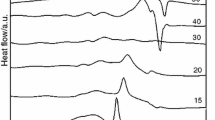Abstract
Calcium-lead-borate glasses containing iron were thoroughly studied by Mössbauer effect spectroscopy aiming to determine both their Debye temperature and their transformation temperature during heating. The obtained Mössbauer effect parameters at room temperature exhibit dispersion of iron ions in a low spin ferric state as modifying cations in a pure amorphous glass matrix. The electric field gradient due to the lattice was stabilized at moderate and high lead oxide content glasses. The high-temperature measurements were carried out between 300 and 750 K under vacuum. It can be concluded that the recoil-free fraction decreased and the mean square amplitude of the Mössbauer atom increased as the temperature was increased. From the Inf againstT curve, the Debye temperature of the solid glass can be calculated (θD = 373.8K). The experimentally determined transformation temperature from this study was found to be 665 K, which may be slightly less than the real value.
Similar content being viewed by others
References
R. F. Guller andE. N. Bunthing,J. Res. Nat. Bur. Stand. 23 (1939) 275.
A. Bishay andM. Maklad, “Proceedings of the Cairo Solid State Conference”, edited by A. Bishay (Plenum, New York, 1967) p. 213.
A. Abou el Azm andA. L. Hussein,Glastech. Ber. 32K(8) (1959) 66.
P. J. Bray, M. Leventhal andH. O. Hooper,Phys. Chem. Glasses 4 (1963) 47.
M. Leventhal andP. J. Bray,ibid. 6 (1965) 11.
G. O. Jones, “Glass”, 2nd Edn (Chapman and Hall, London, 1971) p. 46.
J. T. Littleton,J. Amer. Ceram. Soc. 10 (1927) 259.
Idem, Glastech. Ber. 24 (1940) 176.
A. Abou el Azm andH. A. el Batal,Phys. Chem. Glasses 10 (1969) 4.
C. R. Kurkjian,J. Non. Cryst. Solids 39 (1970) 157.
C. W. Kimball andS. P. Taneja, “Mössbauer Effect Methodology”, Vol. 8, edited by I. J. Gruverman (Plenum Press, New York, 1973) p. 41.
A. A. Belyustin, Yu. M. Ostanvich, A. M. Pisarevskil, S. B. Tomilov, U. Bai-Shi] andL. Cher,Soy. Phys. Solid State 7 (1965) 1163.
S. Reich andI. Michaeli,J. Chem. Phys. 56 (1972) 2350.
A. Simopoulos, H. Wickman, A. Kostikas andD. Petrides,Chem. Phys. Lett. 7 (1970) 615.
E. J. Litterst, R. Ramisch andG. M. Kalvius,J. Non-Cryst. Solids 24 (1977) 19.
A. M. Sanad,Chem. Phys. Lett. 29 (1974) 376.
T. Baak andE. J. Hornyak,J. Amer. Ceram. Soc. 44 (1961) 541.
J. M. Goey,J. Physique (Suppl. 12) 35 (C6) (1974) 89.
S. S. Sekhon andR. Kamal,J. Non-Cryst. Solids 28 (1978) 189.
E. Burzo andI. Ardeleon,Phys. Chem. Glasses 20 (1979).
F. L. Shapiro,Soy. Phys. Usp. 4 (1961) 881.
Author information
Authors and Affiliations
Rights and permissions
About this article
Cite this article
Mostafa, A.G., Awadallah, R.M., Sanad, M. et al. Mössbauer study of the dynamical properties of some lead borate glasses near their transformation temperature. J Mater Sci 21, 965–970 (1986). https://doi.org/10.1007/BF01117380
Received:
Accepted:
Issue Date:
DOI: https://doi.org/10.1007/BF01117380




